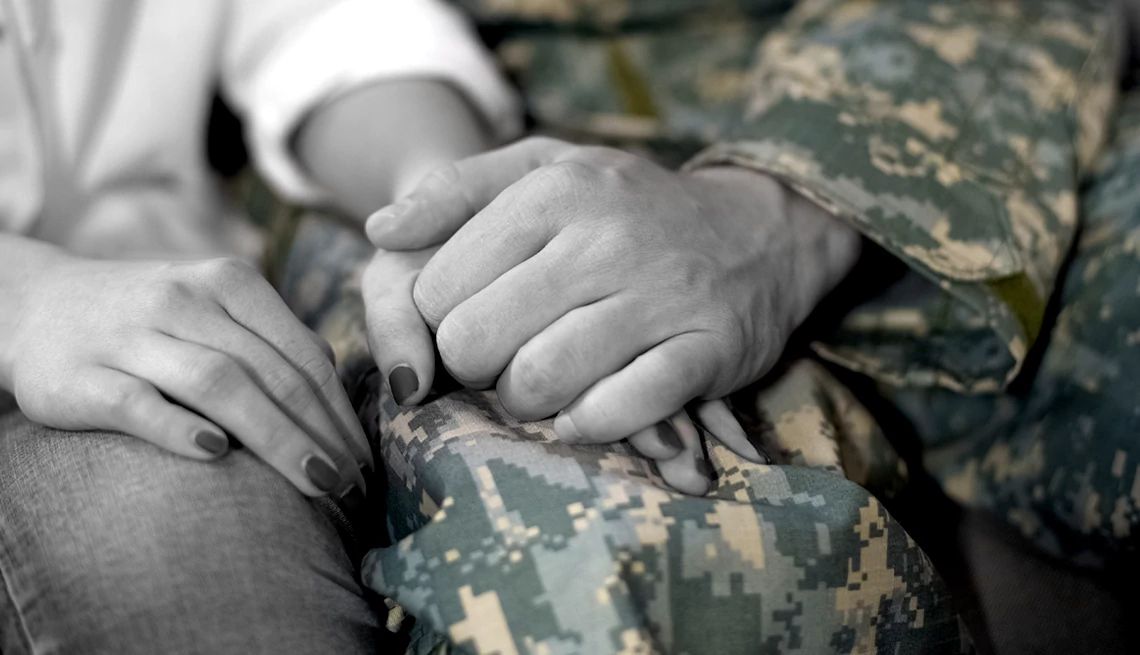AARP Hearing Center


Jump to:
Mary and Steve Stone* • Katie and Bill Wilson* • Ashley and Jack Swanson*
Every year on Veteran’s Day our nation honors those who have sacrificed and served our country. Behind these veterans there are family caregivers who reflect on a very different kind of service and often feel forgotten. Life has not moved forward or gotten easier for many of our nation’s military caregivers, who are silently earning their version of a combat badge, setting aside their own goals and even their identities, long after their loved ones have made it home.
Nancy Treaster, 63, a certified caregiving consultant from Johns Creek, Georgia, is a co-founder of “The Caregiver’s Journey” a podcast and website offering practical advice to caregivers, especially around difficult subjects.
“There is often a sense of pride from the veteran’s perspective around their service,” Treaster says. “But we need to do a much better job helping the caregiving spouse manage the everyday challenges, especially when it comes to resources and support.”
Aging and the physical toll on veteran caregivers
As service members retire from active duty and transition to civilian life, they continue to rely on the people who love them and, in cases of injury, care for them. A share of our veterans suffer from injuries and conditions that will shadow them — and their families —for the rest of their lives.
A Rand study found that while few spouses are prepared to manage the physical and mental injures of war, an estimated 80 percent of veterans will have some need for long-term services and supports in their lifetime. AARP reports that there are 6.5 million miltary and veteran caregivers in the U.S. Roxana Delgado, 47, an epidemiologist and professor at UT Health, San Antonio School of Nursing looks at the long-term effects on veteran caregivers.
“They are great about accessing care for their loved ones, but we need more care and attention on screenings and follow-up for the caregivers themselves,” she says.
Delgado has seen firsthand how the aging process for caregivers looks different than other populations, as the physical and mental health demands of caregiving on the body can accelerate or exacerbate certain health conditions.
“For example, we see 50-year-olds in the general population getting arthritis, but it’s not uncommon to see a caregiver in her 50s needing a hip replacement from 24/7 lifting and bending to tend her son who was wounded in Fallujah, or to see caregivers developing aging-related chronic diseases earlier in life.”
Caregiving spouses often attempt to give their physically or mentally injured veteran partners continued dignity and honor, however traumatic brain injury (TBI), and PTSD, signature wounds of the recent wars, can lead to changes in behavior, increased anger and suicidal thoughts. Spouses and partners of veterans report that these injuries impact not just their loved ones, but their marriage as well, and they often need to find ways to protect other family members from negative emotional effects. The burden of this care and protection can be overwhelming. It’s not unusual for spouses of veterans to develop what is known as secondary PTSD, due to the strain of caregiving and managing a partner’s mental health issues and symptoms.
In sickness and in health
Mary Stone*, 53, from Lexington, Kentucky, met her husband Steve when he was an Army reservist in 1995, after he had deployed to Desert Storm. “In sickness and in health,” she says. “I committed to that, but I didn’t know it was going to be all sickness, and when it’s my sickness, it’s all mine. When it’s someone else’s needs, that has to be the priority. It’s my job to make him feel better.”





































































More From AARP
Caregiving Items that Make Mealtime Easier
Adaptive dinnerware, utensils and tools that reduce stress and boost independence10 Common Mistakes That Family Caregivers Make
Experts share how to avoid these caregiving pitfallsHow to Find Streaming TV Shows for Adults With Cognitive Challenges
Whether it’s ‘I Love Lucy’ or classic sports events, TV can elicit waves of warm feelings and even joy